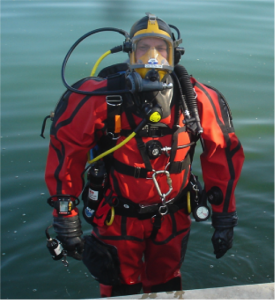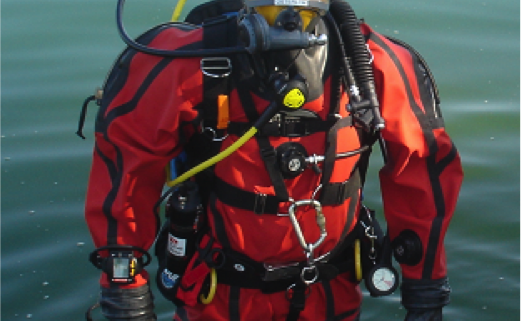The Most Contaminated Dive: Recovering Human Remains

Photo Credit: Riverside Dive Team
It’s a late Thursday evening, the shift operator at the local sewage plant notices something floating in the first settling pond. Upon closer investigation he discovers that it is a hand… A human hand that still has a ring on its finger. He immediately calls the authorities, when the authorities arrive the investigating process proceeds.
Often as public safety divers we face circumstances that may be dangerous and life threatening; either during the dive, or later when we are at home with our families. The first priority as a public safety diver is our safety and well being. After all there is NEVER a time that two dead bodies are better than one. We should always consider our scope of practice and whether it is within our ability to perform the operation we are considering.
Simple questions to ask ourselves: Is this operation beyond my scope of practice and have I been properly trained for this mission? Do I have the proper haz-mat equipment to do the job safely? Should this be a commercial dive operation?
Every public safety diver should have a solid foundation in the basics of Boyles Gas Law. It is imperative to have a good understanding of how Boyles Gas Law relates to decomposition of human tissues at depth. Let’s take a look at how these gas laws can affect our recovery efforts. When it comes to recovering human remains from a liquid environment there are several factors to consider. It has been said that a body that is at a depth of greater than 100ft will not surface on its own accord. Simply put, gases will be at four times the pressure at this depth as they would be at the surface. The total volume of gas at 100ft is 1/4 of the volume it would be at the surface. The likelihood of gas building at this depth is very unlikely. Depths less than 100ft our recovery efforts become a more complex. Decomposition is able to take place at shallower depths as gas production takes effect in the body.With direct relationship to Boyles Gas Law, the body will begin to lift and make its way to the surface due to the decomposition process within the tissues and increased gas production. Besides the contamination hazards that exist we will also need to be concerned with the buoyancy characteristics of tissues after the process of decomposition has occured. The expansion of the body mass due to gas production is now of greater concern and becomes a buoyancy issue that may have direct consequences with our recovery efforts. We must be able to control our ascent to the surface, when recovering a body at depth.
As public safety divers we expose ourselves to environments that are contaminated to varying degrees, whether it be biological, chemical, pesticides, insecticides or other harmful bacterium, the bottom line is this; any body of water must be considered contaminated. We must understand how important it is to protect ourselves against exposure to elements that may be life threatening. The use of the proper protective equipment will significantly lessen the potential risk of exposure. With this in mind, we must protect our mucus membranes as well as our extremities, in order to best accomplish this we should be diving with a full face mask and a dry suit.
I would like to think that most PSD (should we spell out Public Safety Divers here?)dive units are properly trained and understand the importance of using full face masks, with the knowledge and understanding that 90% of our mucus membranes are located on our face. While there are many FFM available on the market today they will all offer some form of contamination protection, some considerations that should be made are as follows. What is the air volume of the mask, and the positive pressures that will allow a greater possibility for water to enter the mask? Both instances may create buoyancy issues and must certainly be considered. Remember that 1 pint of air is equal to 1 pound of buoyancy, given the fact that the head of most adults will weigh between 4 and 6 pounds (dry weight) this doesn’t seem to have much of an effect as you are still negatively buoyant. However, this may become an issue within your attached hood. Air that escaped from the mask may become trapped underneath your hood which may cause you to become positively buoyant. A recommendation to consider is the use of hood vents to manage the escaped air from the mask. These hood vents can be installed easily, but the placement of the hood vents is crucial. Observe the FFM you are diving, you will notice where the spider straps position themselves when tightened. Placing a vent on each side near the back, directly on top of the hood, this placement is the best position to manage the air that may get trapped underneath the hood.
It is the belief of at, Public Safety Dive Services, that you should consider any and every body of water a contaminated body of water, especially if you are in search of a victim. If you are diving a dry suit, you should be trained by a professional ERDI dry suit instructor that completely understands and is familiar with the diving environment and the proper equipment required for every situation.
You will have several factors to consider when diving a dry suit, which depend on the style, the material, the thermals you wear, and the fit of your dry suit. One major factor is buoyancy, air trapped within your dry suit is directly related to buoyancy and may create potential hazards. We should be trained to manage the air within our dry suit to prevent emergency situations. Here are a few considerations: Use a properly fitted dry suit. Use the appropriate thermals that will offer optimal thermal protection for the water temperature you are diving. Know and practice proper donning techniques. Know and use proper burping procedures. Be properly weighted, consider using a weight harness system that allows air to move within the suit. Understand and use proper inlet and exhaust air management skills, this will allow useful and important air management that will help with buoyancy. Practice emergency skills that help protect you from injury.
In short, every public safety diver should have a solid foundation in the basics of Boyles Gas Law. We need to know how to manage our personal air supply at depth. It is imperative to know how Boyles Gas Law relates to decomposition of human tissue at depth, and how it affects our recovery efforts. Public Safety Dive Services offers training that keeps public safety divers as safe as possible.
Public Safety Dive Services
Bo Tibbetts
ERDI Instructor Trainer – 16061
Contact SDI TDI and ERDI
If you would like more information, please contact our World Headquarters or your Regional Office.
Tel: 888.778.9073 | 207.729.4201
Email: Worldhq@tdisdi.com
Web: https://www.tdisdi.com


Dodaj komentarz
Chcesz się przyłączyć do dyskusji?Pomóż nam się rozwijać!